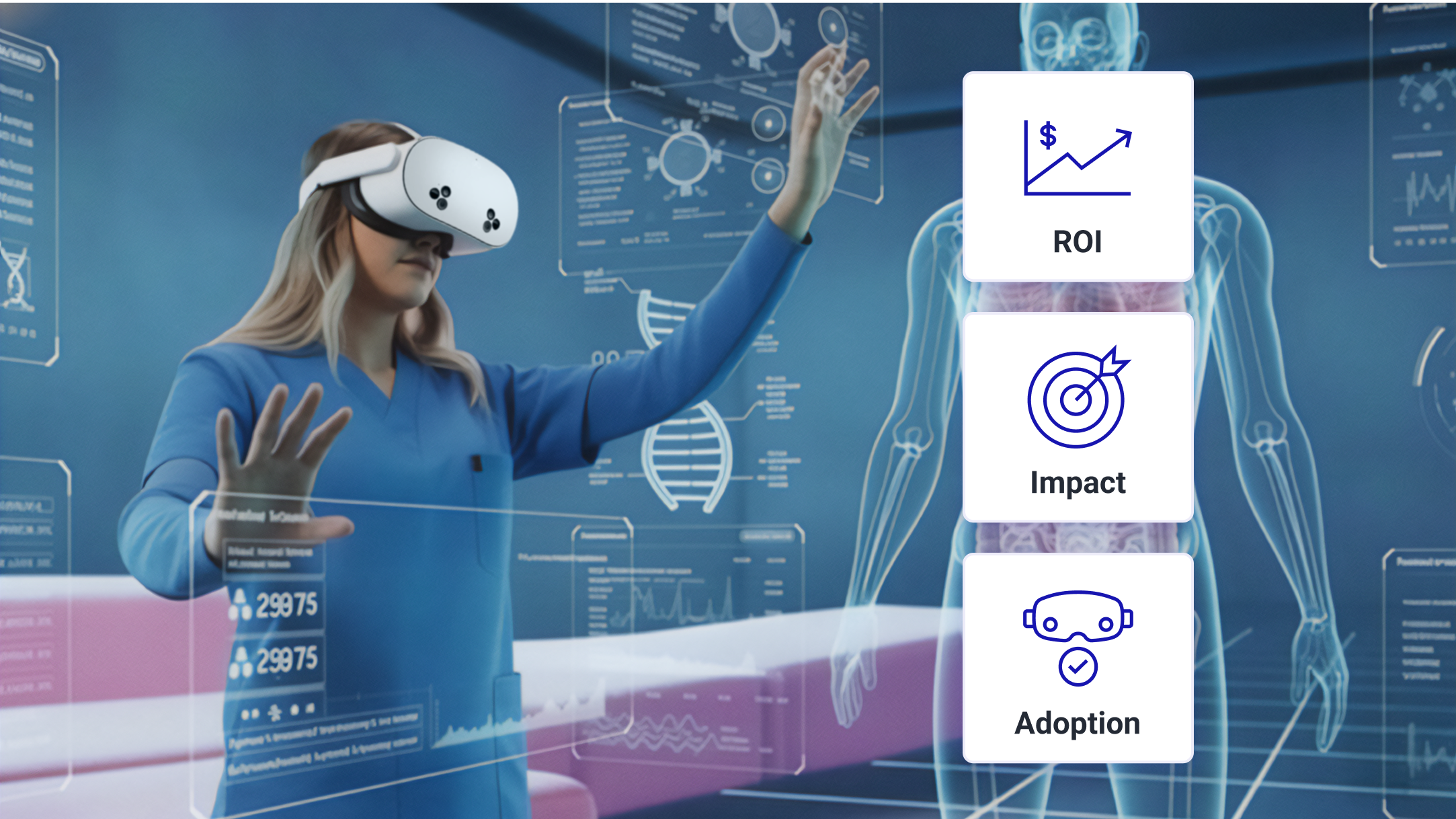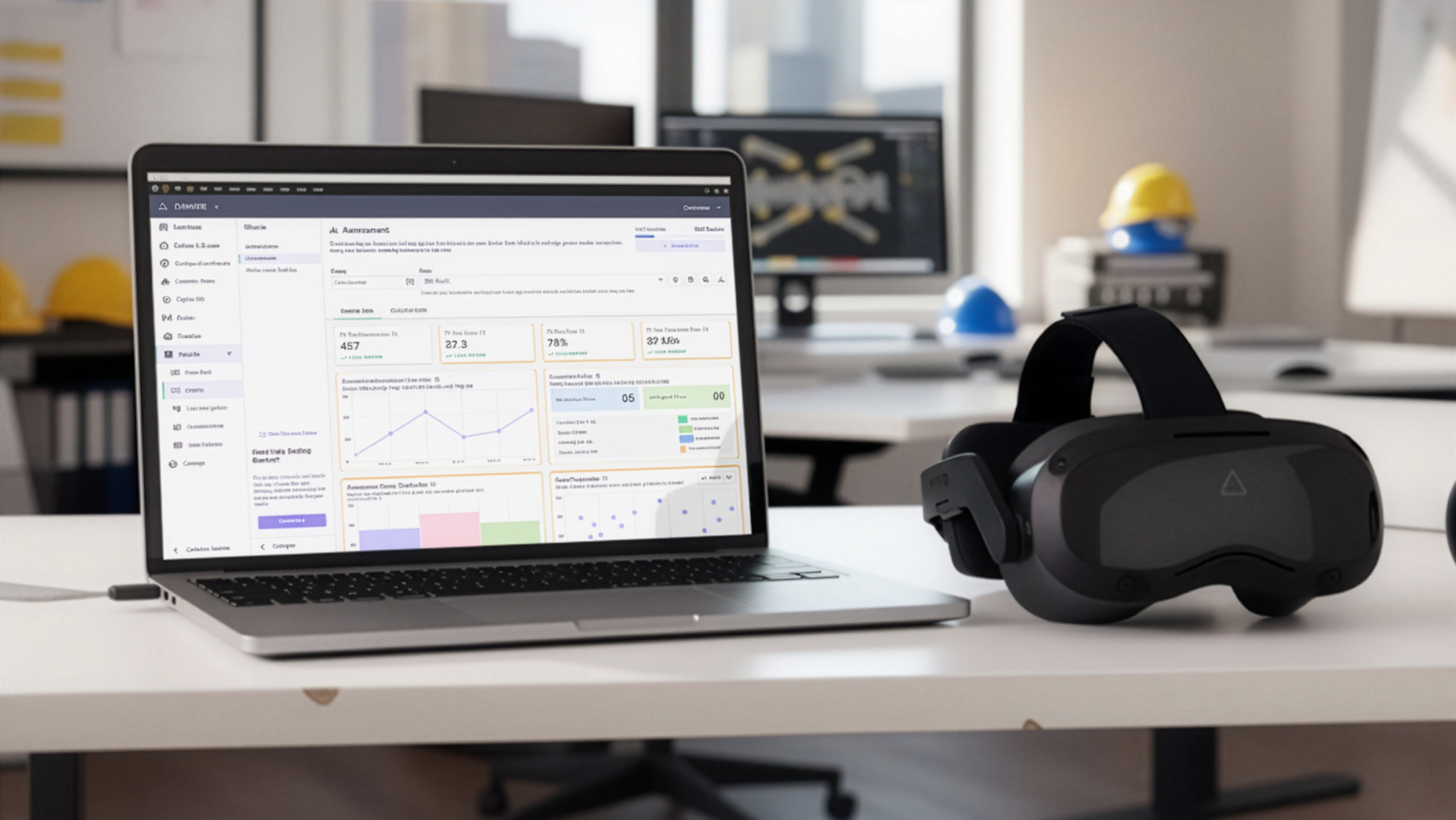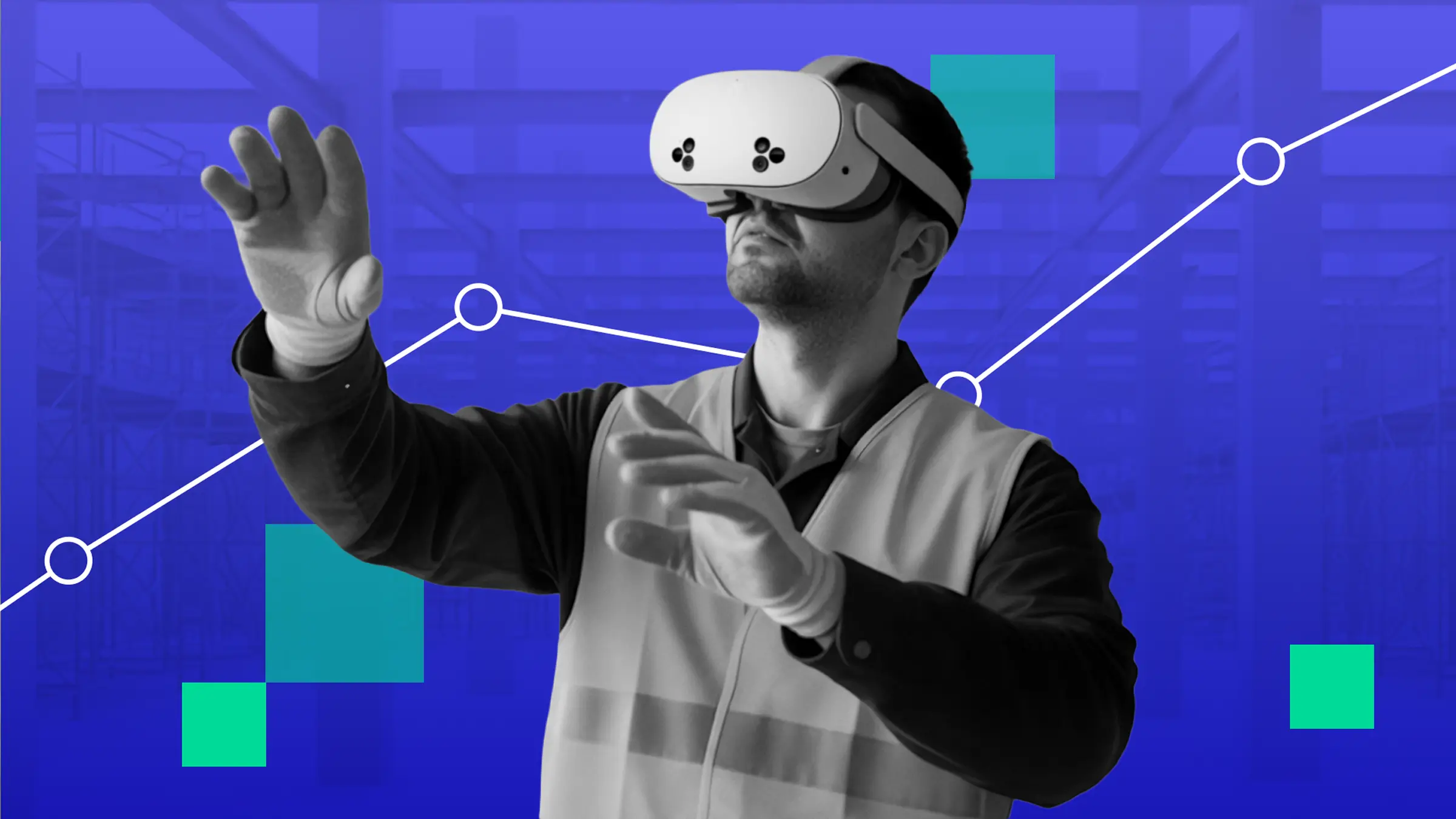Your VR training pilot went really well. People loved it, the feedback was positive, and everyone walked away impressed. Now leadership is asking, "Should we roll this out to more people? What's the actual business impact?"
You have manually tracked completion rates. Maybe some satisfaction surveys. But when executives start asking about dollars and cents, about real business results, you realize your pilot data isn't enough to make a compelling case for expanding the program.
You're definitely not alone. Most VR training programs struggle with this exact challenge bridging the gap between "people liked it" and "here's the financial impact."
Summary
Most organizations treat measurement as an afterthought, then struggle to prove business impact when it's time to expand their VR training programs. Organizations that approach measurement correctly from day one see ROI of 120%+ and build successful, broadly implemented programs.
This article covers the fundamental measurement challenge most programs face, clear definitions of what you should actually be measuring, and the three types of measurement that ultimately help define ROI.
You'll understand why measurement should be a day-one priority, not an afterthought, and how the right measurement infrastructure transforms VR training from experimental programs into strategic business initiatives with quantifiable returns.
Understanding What to Measure and Why

The Challenge Most Programs Face
VR training pilots typically succeed on engagement and satisfaction metrics. Learners report feeling more confident. Managers observe higher engagement levels. The immersive experience generates positive feedback across the board.
The issue isn't whether VR training works. Companies like Walmart train over one million employees with VR and see 70% higher test scores. Boeing achieves 75% reduction in training time with 90% first-time accuracy versus 50% with traditional methods.
The challenge is connecting VR training data to business outcomes in a way that demonstrates clear financial impact. Most pilots rely on qualitative feedback rather than quantitative metrics that map to executive decision-making criteria.
Why Good Feelings Don't Equal Business Cases
Pilot programs operate in controlled environments designed for success. They feature enthusiastic early adopters, dedicated facilitation, and simplified logistics. These conditions produce impressive qualitative results but mask the measurement challenges that emerge when building business cases for expansion.
When executives evaluate major technology investments, they need specific answers to financial questions:
- What's the cost per trained employee?
- How does this compare to existing training methods?
- What's the measurable impact on job performance?
- How quickly do we see returns on investment?
Satisfaction scores and engagement metrics can't answer these questions. Organizations need systematic approaches to capture, analyze, and report quantitative data that connects VR training activities to business outcomes.
This measurement gap explains why so many promising VR pilots fail to secure expansion funding. Without concrete financial data, even successful programs struggle to compete for budget allocation against initiatives with clear ROI documentation.
Defining What You're Actually Measuring

Before building measurement frameworks, organizations need clarity on three distinct but related concepts that often get confused in VR training discussions.
1. ROI (Return on Investment)
ROI represents the financial return generated by VR training investment. In practical terms, this means for every dollar spent on VR training, how many dollars in benefits did the organization receive back?
PwC's comprehensive cost-effectiveness analysis reveals that VR training achieves cost parity with classroom training at 375 learners, becomes equivalent to e-learning costs at 1,950 learners, and delivers 52% greater cost-effectiveness than traditional classroom methods at 3,000+ learners.
ROI calculation requires identifying specific financial benefits:
- Training Cost Savings: Reduced instructor time, facility costs, travel expenses
- Performance Benefits: Faster onboarding, fewer errors, reduced accidents
- Efficiency Gains: Less time away from work, higher productivity levels
2. Impact
ROI takes time to calculate, so a middle ground for measurement is to quantify impact.
Impact measures whether VR training actually improves job performance compared to previous training methods. This goes beyond satisfaction ratings to examine concrete behavioral and performance changes in work environments.
Research published in Nature Scientific Reports involving 200 participants demonstrated 30% increases in safety awareness with statistical significance, while studies show VR training achieves 80% retention rates one year after training compared to just 20% retention one week after traditional methods.
Organizations measuring impact track:
- Knowledge Retention: How much do people remember after 30, 60, and 90 days?
- Skill Application: Do people feel confident applying new skills on the job?
- Performance Changes: Are there measurable improvements in work quality or speed?
- Safety Improvements: Do error rates or incidents decrease after training?
3. Adoption
Impact is a mid-term measurement tactic, but the first thing any organization should track beyond pilot completion is adoption rate, as it forms the foundation for all impact measurement that follows.
Adoption tracks whether people actually use and engage with VR training as intended. High adoption rates are prerequisites for both impact and ROI, but adoption alone doesn't guarantee business impact.
Key adoption indicators include:
- Completion Rates: What percentage of people finish the training?
- Session Duration: Are people spending the expected time in VR?
- Re-engagement: Do people voluntarily return to review or practice?
- User Satisfaction: Do people find the experience valuable and worthwhile?
Understanding these distinctions helps organizations avoid common measurement mistakes. High adoption doesn't automatically mean effective learning. Positive impact results don't guarantee positive ROI. Each metric serves different purposes in building comprehensive business cases for VR training expansion.
The Three-Stage Measurement Approach

Most organizations make the mistake of trying to measure everything simultaneously from day one. This approach typically fails because it spreads measurement efforts too thin and doesn't account for the time required to generate meaningful data.
Successful VR training programs use staged measurement approaches that build capabilities gradually while generating increasingly sophisticated insights over time. These stages represent what to focus on when, not what to ignore. ROI measurement requires months of data accumulation, but organizations need to set up the operational components and baseline comparisons from day one to be ready for ROI calculation when sufficient data becomes available.
The framework below helps set expectations about what you can realistically track and when, while emphasizing the importance of establishing foundational metrics and operations from the start. Without proper groundwork in the early stages, organizations find themselves scrambling to reconstruct baseline data when they're finally ready to calculate ROI months later.
Stage 1: Adoption Measurement (Months 1-2)
The first stage focuses on answering a fundamental question: Are people actually using the VR training as intended? Without solid adoption, impact and ROI measurements become meaningless.
During this stage, organizations track basic usage patterns, completion rates, and user satisfaction levels. They monitor whether people complete training sessions, how long they spend in VR environments, and their immediate reactions to the experience.
This stage also establishes baseline measurements for current training programs. Organizations document existing training costs, time requirements, and performance levels to enable future comparisons.
Early success indicators:
- Completion rates exceeding traditional training methods
- Session durations meeting or exceeding planned timeframes
- Positive user feedback indicating willingness to continue using VR training
Stage 2: Impact Measurement (Months 3-6)
The second stage examines whether VR training actually improves job performance. This stage requires connecting VR training data to workplace behavior and performance metrics.
Organizations begin tracking performance improvements on actual job tasks, knowledge retention over extended periods, and confidence levels in applying newly learned skills. They monitor error rates, safety incidents, and other workplace performance indicators before and after VR training implementation.
Success during this stage appears as measurable performance improvements within 90 days, higher knowledge retention rates than previous training methods, and reduced error rates or safety incidents in trained groups compared to control groups.
Stage 3: ROI Calculation (Months 6+)
The final stage quantifies financial benefits and calculates return on investment. This stage requires sufficient data from previous stages plus extended observation periods to capture longer-term impacts. The baseline measurements established in Stage 1 become critical here for demonstrating before-and-after comparisons.
Organizations calculate training cost savings, performance benefits, and efficiency gains. They document reductions in instructor time, facility costs, and travel expenses. They quantify the value of improved performance, faster onboarding, and reduced accidents or errors.
Proven ROI examples:
- Healthcare organizations report ROI ranges from 120% depending on implementation scale
- Manufacturing sectors show impressive returns through safety training programs
- Retail companies save hundreds of thousands annually eliminating travel costs
This staged approach works because it builds measurement capabilities systematically while generating data that supports increasingly sophisticated analysis. Organizations avoid the common trap of trying to prove ROI before establishing that people actually use and benefit from VR training.
Why Manual Measurement Hits Scaling Walls
While staged measurement approaches provide clear frameworks, manual data collection and analysis methods that work during pilot phases become impossible at enterprise scale.
Pilot programs typically involve small groups where manual tracking seems manageable. Someone can export completion data from VR applications, manually compile satisfaction surveys, and create spreadsheet reports for leadership review.
But scaling to hundreds or thousands of learners transforms measurement from manageable tasks into full-time job requirements. Manual data export becomes time-consuming and error-prone. Spreadsheet compilation grows unwieldy. Report generation consumes weeks rather than hours.
More critically, manual approaches can't capture the granular behavioral data needed for sophisticated ROI analysis. They miss learning patterns, struggle to connect VR activities to business outcomes, and fail to integrate with existing enterprise systems.
Organizations serious about scaling VR training need purpose-built measurement infrastructure that automates data collection, enables real-time analysis, and integrates with existing learning management and business intelligence systems.
The Infrastructure Reality
Comprehensive VR training measurement requires infrastructure designed specifically for immersive learning environments. Traditional learning management systems weren't built to capture VR-specific data like spatial interactions, decision-making patterns, or immersive behavior analytics.
Successful organizations implement platforms that combine device management, content distribution, and learner analytics capabilities. They need systems that can:
- Automate Data Collection: Track granular learner behaviors inside VR applications without manual intervention
- Integrate with Enterprise Systems: Connect seamlessly with existing LMS and business intelligence tools
- Scale Effortlessly: Handle measurement from pilot programs to enterprise deployments
- Generate Executive Reports: Create professional presentations without spreadsheet compilation
The measurement infrastructure must maintain data quality and analytical sophistication while enabling organizations to prove ROI with concrete business metrics, optimize content based on real learner behavior patterns, and make data-driven decisions about program expansion.
How ArborXR Insights Solves the Measurement Challenge

ArborXR Insights was developed specifically to address the visibility and scale challenges that keep VR training programs stuck in pilot phase. Our comprehensive platform combines device management, content distribution, and learner analytics to provide the measurement infrastructure organizations need for successful ROI reporting.
Insights allows customers to connect directly to their training content to capture unparalleled analytics that would be impossible to gather manually. This approach gives organizations granular visibility into learner behaviors inside VR applications while automatically connecting to existing enterprise systems like LMS platforms and business intelligence tools.
The result is comprehensive ROI measurement that scales from pilot programs to enterprise deployments without manual data compilation or spreadsheet reporting. Organizations using ArborXR Insights can prove VR training impact with concrete business metrics, optimize content based on real learner behavior patterns, and generate executive-ready reports that demonstrate clear financial returns.
Ready to transform your VR training measurement from pilot-level tracking to enterprise-grade ROI reporting? Learn more about ArborXR Insights and discover how our platform enables organizations to prove the business impact of their VR training programs.

